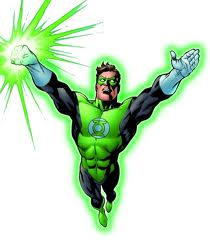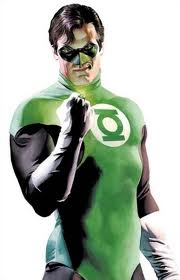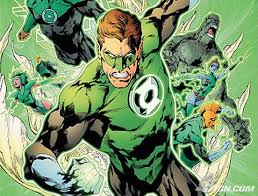Hal Jordan
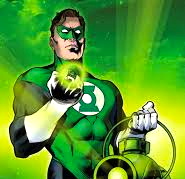
Green Lantern History
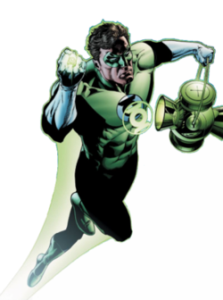 Hal Jordan as Green Lantern
Hal Jordan as Green Lantern
Art by Ethan Van Sciver
Harold “Hal” Jordan is a DC Comics superhero known as Green Lantern, the first human shown to join the Green Lantern Corps and a founding member of the Justice League of America. Jordan is the second DC Comics character to adopt the Green Lantern moniker. Jordan was created in the Silver Age of Comic Books by John Broome and Gil Kane, and made his first appearance in Showcase #22 (October 1959) to replace the original Green Lantern Alan Scott from the Golden Age of Comic Books.
In 1994, the story Emerald Twilight saw Hal Jordan turn into the supervillain Parallax. Later, in the Zero Hour miniseries, he attempts cosmic genocide. He was replaced by Kyle Rayner as the new Green Lantern for the Modern Age of Comic Books. In the 1996 crossover story “The Final Night“, he attempted to return to his heroic roots by dying to save the Earth, and later returned as a spirit of redemption in the persona of the Spectre. Hal Jordan was resurrected in the 2004 miniseries Green Lantern: Rebirth, which revealed that Parallax was actually an alien parasitic entity that influenced his prior villainy. He subsequently returned to the Green Lantern Corps and became the protagonist of the subsequent volumes of Green Lantern.
Hal Jordan was ranked 7th on IGN’s Top 100 Comic Book Heroes in 2011.
 Publication history – Recreated for the Silver Age
Publication history – Recreated for the Silver Age
After achieving great success in 1956 in reviving the Golden Age character The Flash, DC editor Julius Schwartz looked toward recreating the Green Lantern from the Golden Age of Comic Books. Like The Flash, Schwartz wanted this new character to have a different secret identity, origin, and personality than his 1940s counterpart. A long time science-fiction fan and literary agent, Schwartz wanted a more sci-fi based Green Lantern, as opposed to the mystical powers of Alan Scott, the forties Green Lantern. He enlisted writer John Broome and artist Gil Kane, who in 1959 would reintroduce Green Lantern to the world in Showcase #22(September–October 1959).
The character was a success, and it was quickly decided to follow-up his three issue run on Showcase with a self-titled series. Green Lantern #1 began in July–August 1960 and would continue until #84 in April–May 1972.
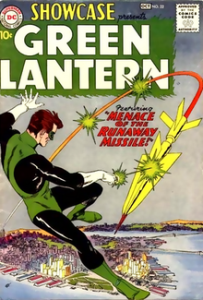 Cover to Showcase #22 (October 1959), the first appearance of Hal Jordan. Art by Gil Kane.
Cover to Showcase #22 (October 1959), the first appearance of Hal Jordan. Art by Gil Kane.
This creative team was responsible for introducing many of the major characters in Hal Jordan’s life. First and foremost was Carol Ferris, Jordan’s love interest. She was in charge of Ferris Aircraft, and as such, Hal’s boss. While she preferred Green Lantern to Hal Jordan, she took an active role in trying to win him over, even going so far as to propose to him in the old Leap Year tradition. Although she gave Jordan some attention, her job and company always came first. Ferris was a strong-willed woman of authority at a time when this was rare, especially in comic books.
Another unique addition to Green Lantern’s supporting cast was his best friend, Tom Kalmaku, who was both Hal’s mechanic and the chronicler of his super-hero adventures, after succeeding in working out his identity. An Inuit (Eskimo) from Alaska, Tom’s nickname was “Pie” or “Pieface,” in reference to Eskimo Pie ice cream sandwiches. Like “Chop Chop” from the Blackhawk comics, this nickname is today understandably viewed as racist and has been downplayed by most modern writers. However, unlike “Chop Chop”, Tom was actually a competent and intelligent character with a well-rounded personality, not a stereotypical buffoon. Despite the unfortunate nickname, Tom Kalmaku was among the first minority characters to be portrayed in this manner and broke new ground for mainstream comic books. Tom would later be followed by another trail-blazing minority character, John Stewart, the first African-American super-hero of the DC Universe.
Jordan’s masters, the mysterious Guardians of the Universe, were physically based on David Ben-Gurion, the first Prime Minister of Israel, and were developed from an idea Schwartz and Broome had originally conceived years prior in a story featuring Captain Comet in Strange Adventures #22 (July, 1952) entitled “Guardians of the Clockwork Universe.”
Schwartz and company also allowed Jordan to have a family, which was another rare thing at this time in superhero comics. While he did not have a wife or children of his own, he had many interactions with his two older brothers, Jack, a district attorney, and Jim, a more comical figure. A reporter, Sue Williams, suspected Jim of being Green Lantern due to his appearance and his reputation of being scatterbrained.
Starting in issue #17, Gardner Fox joined the book to share writing duties with John Broome. The quartet of Schwartz, Broome, Fox, and Kane remained the core creative team until 1970.
Starting with issue #76, Dennis O’Neil took over scripting and Neal Adams, who had drawn the cover of issue #63, became the series’ artist. This issue is one of the comics which is considered to have ushered in the Bronze Age of Comic Books. The collaboration of O’Neil and Adams produced the most famous and celebrated runs on Green Lantern. Julius Schwartz remained editor and hand-selected the two to revitalize the title, the sales of which had been slipping. O’Neil and Adams had already begun preparation for the classic run in the form of their re-workings of another DC superhero, the archer Green Arrow.
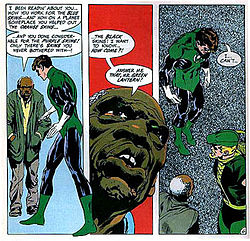 Three panels ushering in the O’Neil/Adams run in Green Lantern #76.
Three panels ushering in the O’Neil/Adams run in Green Lantern #76.
In an introduction to the 1983 reprinting of this O’Neil/Adams run, O’Neil explains that he wondered if he could represent his own political beliefs in comics and take on social issues of the late sixties and early seventies. O’Neil devised the idea of pitting Hal Jordan, who as an intergalactic cop and a crypto-fascist who stood, not only law and order, but The Establishment, against Oliver Queen (Green Arrow), who O’Neil had characterized as a lusty outspoken anarchist who would stand in for the counter-culture movement, (Green Lantern/Green Arrow Vol.1 No. 1 1983 DC Comics). The first issue he wrote had Green Lantern capturing a street”punk who was pushing around a man. All around him, people start throwing things at the bewildered Jordan. As he steps in to attack, he is stopped by Green Arrow, who explains that the man he defended was a slum lord and goes even further to show Lantern the conditions of the slum. At the roof, in a now famous scene, an elderly African-American man grills Jordan as to why he allowed segregation against African-Americans to continue on Earth, when he saved “the orange skins” and “the purple skins” from exactly that.
Following Schwartz’s approval of the story, Neal Adams was brought in to replace Kane, much to O’Neil’s surprise. The pair had previously done a Batman (where Adams successfully reconstructed the character into a more dramatic “Dark Knight”), and Adams had redesigned Green Arrow’s costume. The pair tackled a social issues including corruption, sexism, cults, consumerism, the environment, racism, poverty, and even (subtly) child molestation. However, none were more shocking and controversial than the issue explored in the famous “Snowbirds Don’t Fly” issues #85 and #86. Neal Adams drew the cover, which showed Green Arrow’s youthful side-kick, Speedy, shooting heroin. Editor Julius Schwartz did not want it published. Neither did publisher Carmine Infantino. But over at Marvel Comics, Stan Lee had green-lit The Amazing Spider-Man #96, which featured pills and presented an anti-drug message without the Comics Code Authority seal. Facing opposition and controversy, the Comics Code Authority revised its rules in regard to what could and could not be presented in comic books and, while still restrictive, became more lenient. As a result, DC Comics approved Adams’ cover and O’Neil wrote a two-part story involving drugs with Speedy being hooked. New York Mayor John V. Lindsay wrote a letter to DC Comics in response to the issue commending them, which was printed in issue #86.
Due to low sales Green Lantern/Green Arrow was cancelled. Schwartz had a reprint of an older story published for issue #88 and saw the comic he began back in 1959 come to an end in 1972 with issue #89. However, he had O’Neil and Adams do one last story together, stretched out over Flash #217-219 as a backup story. Green Lantern continued to appear in backup stories of Flash from 1972 until the Green Lantern title was resumed in 1976.
From Green Lantern #151 (April 1982) until #172 (January 1984), Jordan was exiled into space for a year by the Guardians in order to prove his loyalty to the Green Lantern Corps, having been accused of paying too much attention to Earth when he had an entire “sector” of the cosmos to patrol. When he returned to Earth, he found himself embroiled in a dispute with Carol Ferris. Faced with a choice between love and the power ring, Jordan chose to resign from the Corps. The Guardians called upon Jordan’s backup, John Stewart, to regular duty as his replacement.
In 1985, the “Crisis on Infinite Earths” storyline that rebooted much of DC Comics’ character continuity saw Jordan again take up the mantle of Green Lantern. The new Corps, with seven members residing on Earth, included several aliens, John Stewart, and Guy Gardner. Jordan became romantically involved with an alien Lantern named Arisia, for which he came under fire; a difference in time between Earth and her planet meant that in Earth years, she was over 250 years old, while on her planet she was only 14 years old. The alien Lanterns took a more direct hand in human affairs, a fact not appreciated by human governments. (Kilowog helped create the Rocket Reds for the Soviet Union). Eventually, the Earth corps broke up, several members returning to their home sectors. The Guardians soon returned to this dimension, and Jordan worked with them to rebuild the fractured Corps.
During this time, the character’s origin story is re-told and expanded in two limited series by Gerard Jones, Emerald Dawn and Emerald Dawn II. The first series expanded the role of the Corps in his origin and also provided more details about his childhood and his relationship with his father and brothers, while the sequel detailed the role of Jordan in the downfall of Sinestro.
In the 1992 prestige format graphic novel Green Lantern: Ganthet’s Tale (ISBN 1-56389-026-7) (story by Larry Niven, script & art byJohn Byrne), Hal Jordan first encounters Ganthet, one of the Guardians of the Universe. He asks Hal to help Ganthet battle a renegade Guardian, Dawlakispokpok (or Dawly, for short) who has attempted to use a time machine to change history.
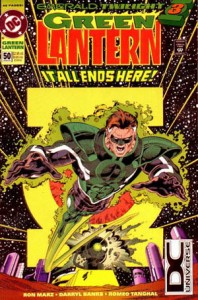 Cover to Green Lantern(vol. 3) #50 (March 1994). Hal Jordan becomes Parallax. Art by Darryl Banks.
Cover to Green Lantern(vol. 3) #50 (March 1994). Hal Jordan becomes Parallax. Art by Darryl Banks.
In the 1993 Reign of the Supermen! storyline, the villainous Hank Henshaw disguised as a reborn Cyborg Superman enlists the alien tyrant Mongul and his forces and comes to Earth in a plot to take advantage of the death of Superman. In the process, Coast City (Jordan’s former home) is destroyed and all of its seven million inhabitants murdered, bringing Jordan to take revenge on Mongul, who has replaced it with Engine City, with which he plans to turn Earth into a new Warworld. Jordan was off world at the time of the attack on his hometown, having returned well after its destruction. Angered, he flies into Engine City and makes short work of Mongul’s guards. Jordan then bum-rushes Mongul, who at that moment was seconds away from killing a weakened Superman. Since Mongul’s skin pigment was yellow and Engine City was powered by Kryptonite gas, Jordan had a somewhat difficult time fighting the hulking alien. After the fight results in Jordan’s arm and knee being broken, he takes advantage of Mongul’s arrogance and uses his ring to create power armor for himself with which he used to lift Steel’s (John Henry Irons‘) hammer and strike Mongul with it. The blow was so powerful that the hammer was shattered into pieces and Mongul was knocked out and eventually incarcerated. It was later revealed that the Cyborg Superman’s wife came from Coast City, and he destroyed it as he wanted to remove all traces of his past life. This leads into the Emerald Twilight three-part arc: Jordan uses his power ring to recreate Coast City as an instrument in the process of overcoming his grief, talking to ring created versions of his old girlfriend and parents. After his ring’s power expires a projection of a Guardian appears and admonishes him for using the ring for personal gain and summons him to Oa for trial. Angered at what he sees as the Guardians’ ungrateful and callous behavior, Jordan absorbs the energy from the Guardian’s projection, goes insane and attacks Oa to seize the full power of the Central Battery, destroying the Corps in the process, taking their power rings as his own and leaving them to die in space, and ending the arc when he kills Kilowog, Sinestro who has been resurrected to fight him but has his neck snapped, and all the Guardians except for Ganthet who was protected by the other Guardians and survived without Jordan’s knowledge. He then renounces his life as Green Lantern, adopting the name Parallax after absorbing the Power Battery’s vast powers. After he emerges from the Central Power Battery, he walks past and looks at the dead Guardians and steps on his former ring, crushing it in the process.
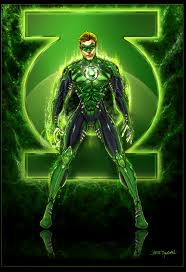 Jordan is replaced by Kyle Rayner by Ganthet as the Green Lantern of Earth when Rayner comes into possession of the last power ring, created from the shattered remains of Jordan’s. Shortly afterward, Guy Gardner has visions of the Green Lantern Corps’ destruction and his yellow power ring’s energy (being powered by residual Green Lantern’s energy) starts to fluctuate. Soon after, Gardner goes to Oa to investigate. He brings Martian Manhunter, Darkstar (Ferrin Colos), The Ray, Wonder Woman, Captain Atom, Alan Scott and Arisia with him for back up. Upon arrival they discover Kilowog’s corpse. Jordan uses the element of surprise, attacks them, and quickly and easily defeats them. Although Guy tricks Hal into thinking that he is dead by making a fake dead construct of himself. He engages in battle with Parallax, absorbing his energy as they fight. But ultimately Jordan is too powerful for Gardner and defeats him in minutes, destroying his yellow power ring and punching out his eye putting Guy in a coma. After the battle Hal sends them all back to Earth warning them to leave him alone in the future. Not long afterwards, Parallax attempts to rewrite history to his own liking with the help of Extant in Zero Hour: Crisis in Time. Parallax destroys the Time Trapper and attempts to remake the universe into a perfect, peaceful place. The process causes time disruptions throughout time. Superman, Kyle Rayner and Metron call upon Earth’s heroes to stop this crisis. Parallax reveals himself as the enemy by knocking out Superman with a single blow. Parallax and Exant battle the wide array of heroes. They are eventually defeated, with Green Arrow shooting an arrow into Jordan’s heart as Kyle Rayner holds him in a full-nelson. Later, in the 1996 Final Night miniseries/crossover storyline, Jordan returns when the Earth’s sun is in danger of going out. He starts to reevaluate himself and the decisions he’s made and attacks and kills the Cyborg Superman (although he is later revealed to be alive) and visits John Stewart in the hospital who was recently paralyzed in battle. Jordan talks to his old friend for a final time and uses his powers to heal his paralysis. He then uses what appears to be the last of his powers and sacrifices his life to reignite the Sun (which had been extinguished by the Sun-Eater).
Jordan is replaced by Kyle Rayner by Ganthet as the Green Lantern of Earth when Rayner comes into possession of the last power ring, created from the shattered remains of Jordan’s. Shortly afterward, Guy Gardner has visions of the Green Lantern Corps’ destruction and his yellow power ring’s energy (being powered by residual Green Lantern’s energy) starts to fluctuate. Soon after, Gardner goes to Oa to investigate. He brings Martian Manhunter, Darkstar (Ferrin Colos), The Ray, Wonder Woman, Captain Atom, Alan Scott and Arisia with him for back up. Upon arrival they discover Kilowog’s corpse. Jordan uses the element of surprise, attacks them, and quickly and easily defeats them. Although Guy tricks Hal into thinking that he is dead by making a fake dead construct of himself. He engages in battle with Parallax, absorbing his energy as they fight. But ultimately Jordan is too powerful for Gardner and defeats him in minutes, destroying his yellow power ring and punching out his eye putting Guy in a coma. After the battle Hal sends them all back to Earth warning them to leave him alone in the future. Not long afterwards, Parallax attempts to rewrite history to his own liking with the help of Extant in Zero Hour: Crisis in Time. Parallax destroys the Time Trapper and attempts to remake the universe into a perfect, peaceful place. The process causes time disruptions throughout time. Superman, Kyle Rayner and Metron call upon Earth’s heroes to stop this crisis. Parallax reveals himself as the enemy by knocking out Superman with a single blow. Parallax and Exant battle the wide array of heroes. They are eventually defeated, with Green Arrow shooting an arrow into Jordan’s heart as Kyle Rayner holds him in a full-nelson. Later, in the 1996 Final Night miniseries/crossover storyline, Jordan returns when the Earth’s sun is in danger of going out. He starts to reevaluate himself and the decisions he’s made and attacks and kills the Cyborg Superman (although he is later revealed to be alive) and visits John Stewart in the hospital who was recently paralyzed in battle. Jordan talks to his old friend for a final time and uses his powers to heal his paralysis. He then uses what appears to be the last of his powers and sacrifices his life to reignite the Sun (which had been extinguished by the Sun-Eater).
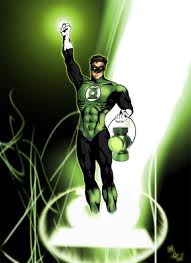 During the Emerald Knights storyline, when Kyle Rayner goes on an accidental time-travelling trip, he ends up unintentionally drawing a past version of Hal into the present where Hal is shocked to learn of the crimes his future self had committed as Parallax. Although Hal briefly thought about remaining in the present to escape his actions as Parallax, Parallax’s appearance in the present while preparing to recreate the universe, he had been travelling back to his present from the future and became aware of his younger self existing where he should not forced Kyle to realise that both Hals had to go back where they came from in order to ensure that the Sun-Eater is defeated.
During the Emerald Knights storyline, when Kyle Rayner goes on an accidental time-travelling trip, he ends up unintentionally drawing a past version of Hal into the present where Hal is shocked to learn of the crimes his future self had committed as Parallax. Although Hal briefly thought about remaining in the present to escape his actions as Parallax, Parallax’s appearance in the present while preparing to recreate the universe, he had been travelling back to his present from the future and became aware of his younger self existing where he should not forced Kyle to realise that both Hals had to go back where they came from in order to ensure that the Sun-Eater is defeated.
In the 1999 mini-series Day of Judgement, Jordan becomes the newest incarnation of the Spectre, released from Purgatory after a fallen angel attempted to take that power. Soon after assuming this mantle, Jordan chooses to bend his mission from a spirit of vengeance to one of redemption, also making other appearances through some of DC Comics’ other story lines, such as advising Superman during the Emperor Joker storyline (Where the Joker steals the reality-warping power of Mister Mxyzptlk) and erases all public knowledge of Wally West‘s identity as the Flash after his terrible first battle with Zoom, which led to his wife miscarrying their twins. He also appeared in a 4-part story arc in the series Legends of the DC Universe (issues #33-36). A new series based on this premise, titled The Spectre (volume 4), ran for 27 issues from 2001 to 2003.
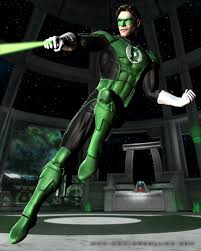 During the Identity Crisis storyline, Hal is visited by Green Arrow asking to exact revenge that he had might knew Sue Dibny‘s killer is, although Hal refused as the Spectre to a higher purpose.
During the Identity Crisis storyline, Hal is visited by Green Arrow asking to exact revenge that he had might knew Sue Dibny‘s killer is, although Hal refused as the Spectre to a higher purpose.

